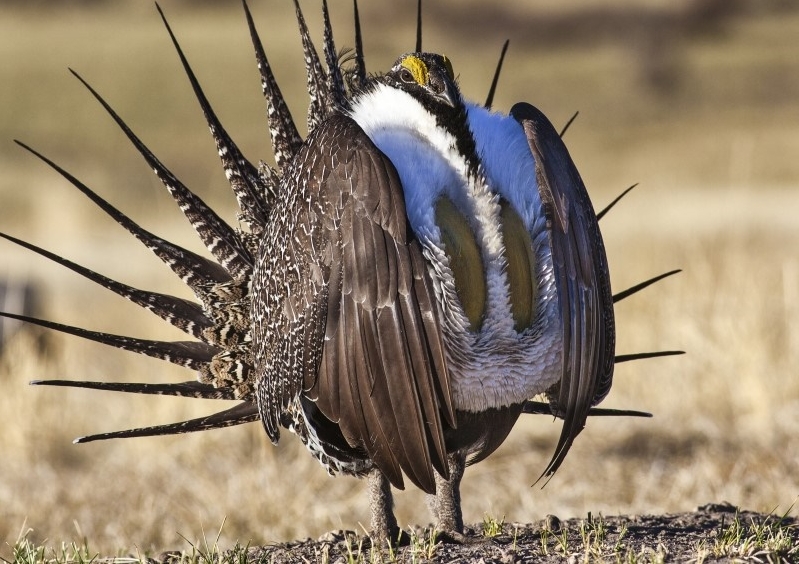
COMMERCE CITY, Colo. (Reuters) - A long-simmering debate in the American West over the fate of a ground-dwelling bird reached a climax on Tuesday as the Obama administration denied Endangered Species Act protections to the greater sage grouse in favor of less rigid habitat conservation measures.
Interior Secretary Sally Jewell said the need to list the charismatic bird as threatened or endangered was averted by the success of "unprecedented" collaboration among state and local governments, scientists, ranchers and other private interests over the last five years.
She credited those efforts with significantly reducing threats to the sage grouse across 90 percent of its breeding habitat, staving off any immediate risk of extinction.
"This is the largest, most complex land conservation effort in the history of the United States," Jewell told a news conference, joined by four Western governors and a host of top federal land managers, at a wildlife refuge in Colorado.
The plight of the grouse, a key indicator species for the vanishing sagebrush ecosystem of the American prairie, has pitted conservation groups against oil and gas drilling, wind farms and cattle grazing in one of the biggest industry-versus-nature controversies in decades.
Tuesday's announcement marked a turnabout from a 2010 finding by the U.S. Fish and Wildlife Service, an Interior Department agency, that endangered species protection for the grouse was warranted but that other species were a higher priority.
The conservation strategy implemented since then offers an alternative for saving the grouse while allowing activities such as energy development, mining and ranching to co-exist with the chicken-sized prairie fowl, Jewell said.
The greater sage grouse, known for its elaborate mating rituals, once ranged by the millions across a broad expanse of the western United States and Canada.
They are now believed to number between 200,000 and 500,000 birds in 11 Western states and southern Alberta.
Despite long-term declines, sage grouse populations "remain relatively abundant and well-distributed" across the bird's 173-million-acre (70-million-hectare) range, Fish and Wildlife officials said.
Fish and Wildlife Service chief Dan Ashe said losses were expected to continue, "but we believe at declining rates."
In addition to conservation programs for state and private lands representing 45 percent of sage grouse habitat, a patchwork of 98 U.S. land use plans also were revised to protect the bird on federal property that accounts for most of the rest.
The federal plans impose a new set of tiered limits on development inside 67 million acres (27 million hectares) of designated habitat, with tougher restrictions on about half the total. Even more stringent protections will apply to a subset of those "priority" zones comprising 12 million acres (4.8 million hectares).
Officials also pointed to newly adopted plans for curtailing two key environmental threats - rangeland wildfires and the spread of an invasive weed known as cheatgrass.
The announcement was immediately welcomed by the Denver-based industry group Western Energy Alliance and the Colorado Cattlemen's Association while receiving mixed reviews from environmental groups.
National Audubon Society President David Yarnold endorsed the decision, calling it "a new lease on life for the greater sage grouse and the entire sagebrush ecosystem."
But Erik Molvar, a wildlife biologist for WildEarth Guardians, said the plans offered too little protection with too many loopholes, though he said his group would review the details before deciding whether to bring a court challenge.
Protections from oil and gas drilling, for example, are much weaker in Wyoming, which accounts for 40 percent of all sage grouse habitat, than in other states, Molvar said.
Unlike many such battles of the past, commercial interests this time have embraced conservation efforts aimed at avoiding potentially tougher restrictions under the Endangered Species Act.
Many ranchers, in particular, found common cause with efforts to protect Western rangelands on which their livestock depend, often citing the rallying phrase, "What's good for the bird is good for the herd."
The U.S. Department of Agriculture has worked with 1,100 ranchers to restore or conserve 4.4 million acres (1.78 million hectares) of key habitat, and the USDA said it expects voluntary, private land conservation efforts to reach 8 million acres (3.2 million hectares) by 2018.
(Additional reporting by Laura Zuckerman in Salmon, Idaho; Writing and additional reporting by Steve Gorman in Los Angeles; Editing by Bill Trott and Sandra Maler)







